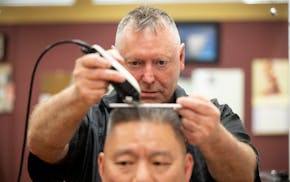Artist Gene Palusky struggled financially in the early 1980s to make a living off his passion for creating ceramic sculptures.
So, the handy Macalester College grad started repairing old properties.
Palusky moved into a house in Minneapolis' Bryn Mawr neighborhood in 1987, renovated it and made a few thousand bucks on the sale two years later. He made $13,000 on the next one, after five months of ownership. There were others. He bought, renovated and operated apartment buildings.
He grossed a few million bucks when he sold his rental properties a couple of years ago.
"I lost interest in making money," said Palusky, 62, who grew up modestly in Eveleth on the Iron Range. "I have everything I want and enough for the rest of my life. I don't need another million dollars."
Palusky lives comfortably with his family in a nice house in an old Edina neighborhood. He has the kids' education covered and he doesn't sweat the mortgage. However, since 2015, he's worked for nothing on a startup in which he's invested more than $300,000.
It's called the XTorch, designed to bring lightness to dark, impoverished corners of the Earth. It's a solar-powered flashlight, lantern and cellphone charger. And it's already a game-changer for several thousand people around the globe.
The idea grew out of Palusky's mission service.
Palusky spent nine months in 2001 as a volunteer in the tiny town of El Toro in the Dominican Republic, building a community center and teaching English to kids. He was struck by the warmth of the people, as well as the dangerous, jury-rigged electrical system.
And it's where he met his wife, Keidy Palusky, 46, a substitute Minneapolis schoolteacher. The Paluskys later traveled to Equatorial Guinea in Africa on a mission trip through Keidy's church, working in dirt-poor schools and building latrines.
Kids there and elsewhere without electricity studied by dangerous kerosene lamps or candles, if they were lucky. Moreover, people in developing countries are reliant on cellphones for communication and small business. Reliable light and communications leads to greater literacy, safety and self-sufficiency.
Palusky hired an engineer to integrate several functions needed by village users into what became XTorch: a mobile, solar-powered instrument that can run for hours as a flashlight, reading lantern, cellphone charger and more, thanks to a lithium-ion phosphate, long-charge battery. A sun-charged battery can provide up to 48 hours of service. It takes an hour to charge it off a wall socket.
Palusky also was informed by work he had done with his brother, an electrical engineer who runs Renew World Outreach, a Christian-based nonprofit that also makes solar-powered audiovisual teaching tools for use in remote places.
The Paluskys decided to form a for-profit company, EJ Case. It would use the full-price online sales of the XTorch to, eventually, help subsidize distribution through nonprofit partners. Gene Palusky said EJ Case last year gave away about 1,500 torches, sold 1,200 at cost to nonprofits and sold about 200 torches for the full price of $60.
The XTorch recently got a complimentary online blog from GearJunkie and glowing reviews from Compassion International and several other nonprofits that distribute them to needy folks. The torch works well in the jungle, a village or on a Minnesota camping trip.
At Buckner Dominicana, a ministry in the Dominican Republic, recipients broke into applause when they received XTorches.
"Besides saving money by not having to buy candles … my children can do their homework at night … it helps me to make dinner and, as an added bonus, I can charge my phone," one mother told Keidy Palusky.
"They told us we were on the right track," she added. "We just donated another 100 to Haiti."
In nearby Haiti, XTorch nonprofit recipients such as Medical Ambassador International use the devices to help train midwives and for their nighttime visits.
Another Haitian nonprofit, Compassion International, has distributed 200 XTorches to needy families with school kids.
There are a couple of competitors that sell solar-powered lanterns, but they lack the integrated features.
The Paluskys have accomplished goal one: creating a reliable, multipurpose product that benefits those who struggle to achieve safety, education and economic self-sufficiency. The bigger challenge for the Paluskys is driving revenue from market sales, to outdoor enthusiasts and others, including on Amazon for $65 per unit. At least 25 percent of those sale proceeds, what would have been profit, go toward purchase credits for select nonprofits for additional XTorches.
XTorch has just begun social-media marketing and recently overhauled its website (xtorch.org) as it scales online retail operations.
"Our business model states that we will have revenue around $200,000 this year," Gene Palusky said. "And double that yearly to total revenue of $3.2 million by 2024."
The Paluskys want to build a growth company that allows them to subsidize hundreds of thousands of XTorches for needy folks through nonprofit partners. And they will continue to invest in the operation.
"I think we're on the cusp of something," Gene Palusky said. "This excites me in a way that making money no longer did."
Neal St. Anthony has been a Star Tribune business columnist and reporter since 1984. He can be contacted at nstanthony@startribune.com.

St. Anthony: 'Patient' investing paying off for St. Paul's Hill Capital

Jennifer Smith, leader of Burnsville's Innovative Office Solutions, has died

St. Anthony: Medical professions in Minnesota need more people of color in their ranks



